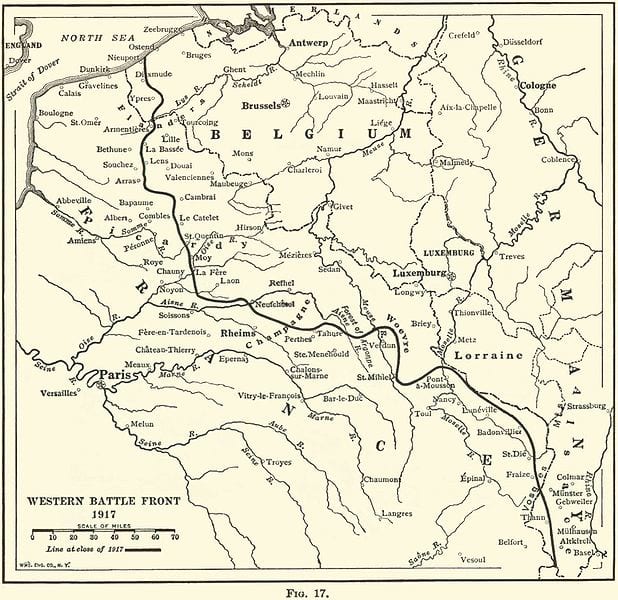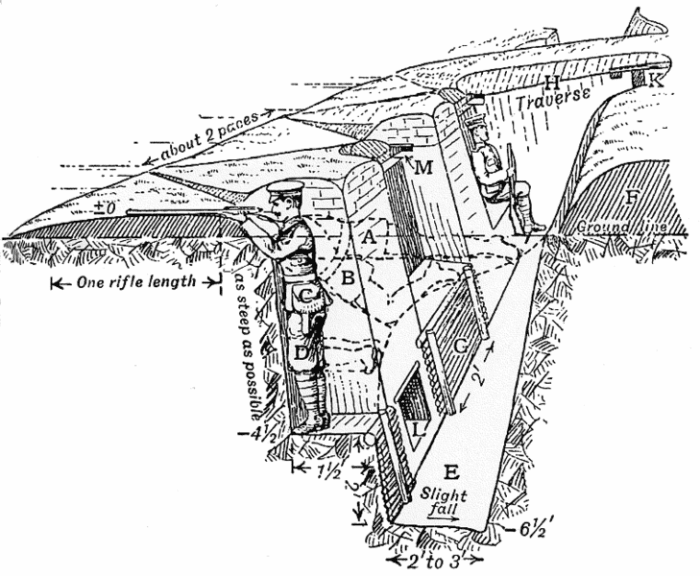WWI Trench Warfare

After a poison gas attack the smell would linger for days, adding to the many pungent aromas in the trenches.
National Archives and Records Administration@wikimedia commons Public Domain
WWI's Battleground
On the 28th of July 1914, WWI began, and soldiers from both sides of the battle began digging big holes in the ground where they would live, eat, sleep, fight and die together.
The trenches became the battleground of the Great War, as well as the final resting place for millions of young men, some as young as seventeen years old.
Most of the men who served in the trenches between 1914 and 1918 were not really soldiers. They were either volunteers who gave up their everyday jobs to serve their country in its time of need, or they were drafted; as the war progressed, subscription was introduced, and if your name was called, then you had to enlist in the armed services.
After six weeks of basic training, the young men were sent to war, really unprepared for the unimaginable horrors that lay ahead of them.

The bolded black line on the map shows where the trenches stretched from the North Sea to the Swiss border.
The Western Front WWI
The Western Front during WWI stretched from the North Sea at Belgium to the Swiss frontier with France, over 240 miles long. Fighting a war in the trenches would bring an end to speculation of a quick war that would be over by Christmas.
Trench Warfare
Trench warfare meant a long, drawn-out war, a stalemate; men would be shot down in the thousands as they tried to go over the top into the enemy trenches. Most were hit before they could even get 50 yards out of their own trenches, making it almost impossible for either side to gain ground on the other.
Holes in the ground were home to millions of soldiers throughout the war years, and although many men died in battle, just as many were killed by disease or infection brought on by the inhuman, unsanitary conditions of life in the trenches.
Smells in the Trenches WWI
New recruits, on their initial approach to the trenches, would often be overcome by the putrid stench that hit them; for some men, it would be too much, and they would become physically sick even before they reached the front line.
Rotting flesh from bodies in shallow graves, overflowing cesspits full of feces and urine, and the creosote and chlorine used to cover up the cesspits and to try to stave off infections or disease all made up an unbearable stench. Adding to the smell were also millions of sandbags rotting from dampness from the rain, stagnant mud, cigarette smoke and even the smell of the men already in the trenches who hadn't managed to have a decent wash in weeks.
The smell of battle also filled the air, stinging the nostrils of new recruits: acrid cordite smells from the ever-lasting heavy shell fire, the lingering odor of poison gasses that were sometimes used, and, of course, the gunpowder smell from the soldiers' firearms.
The soldiers never really got used to the smell but became accustomed to living with it. Some soldiers claimed that the smell never left them, even years after the war was over.

A typical trench used during world war one. This diagram does not really show the difficulties soldiers faced every day.
Disease and Infection in the Trenches of WWI
The soldiers were never alone in the trenches; many creatures also made the trenches their home, which was not really unexpected when you consider the abundance of food that life in the trenches created for them. These creatures were to play a big factor in the health of the fighting soldiers, as they were all carriers of disease and infection.
Recommended
Rats in the Trenches
Rats thrived in the trenches. Almost everywhere you looked, rats would be running around in the thousands, eating human remains, dead insects and anything else that would fit in their mouths. The rats were beyond human control because they were in their ideal breeding ground; for every 10 rats killed, another 100 would be born. Some of the rats were so well fed that they grew to the size of a domestic cat.
It was a widespread belief amongst the soldiers in the trenches that the rats knew in advance when the enemy was going to attack with a heavy bombardment of shells; the rats always seemed to disappear minutes before an enemy attack.
Lice in the Trenches
Lice were ever-present in the trenches and caused a lot of problems for soldiers. Although a lot of the men shaved off every bit of hair from their heads and bodies, the lice lived in their clothes and fed on their blood.
Even when their clothes were washed and deloused, some eggs still survived in the seams of the soldiers' uniforms and would re-infect them.
Lice were carriers of trench fever, a particularly painful disease that began suddenly with severe pain followed by high fever, which took up to 12 weeks to recover from. It wasn't discovered until 1918 that the lice were the cause of it.
Frogs in the Trenches
Millions of frogs were found in water holes made by shell fire and in the bases of the trenches, along with slugs and horned beetles that lined the walls. Nits were also a major problem, again forcing men to shave their head and body hair.
Flies and Maggots in the trenches
With so much rotting flesh around, flies and maggots were a constant problem with the soldiers. They were everywhere and anywhere, and most soldiers wrapped scarves or towels around their mouths to avoid swallowing them. Flies were responsible for the spread of many infections and diseases in the trenches.
Trench Foot
The trenches were always waterlogged, which meant that the soldiers living in them always had wet feet. This caused a major problem called trench foot, especially if it was left untreated for a while. Trench foot is a fungal infection of the feet which, if not treated, can get easily infected and turn gangrenous, leading, in most cases, to amputation of some or all of the foot. In 1915, duck boards were quickly introduced into the trenches, placed above the common waterlines as a prevention, and although there were still a few sufferers throughout the duration of the war, trench foot saw a rapid decline.
Two percent of the men serving in the trenches between 1914 and 1918, around eighty thousand of the men who fought in the war, were the victims of shell shock.
The early symptoms of shell shock included constant tiredness, irritability, dizziness, headaches and trouble concentrating. Eventually, these men would suffer from a full mental breakdown, making it impossible for them to remain on the front line.
It was concluded that the constant barrage of shell fire from both sides was to blame; an exploding shell created a vacuum in the head, and when the air rushed into that vacuum, it would disturb the cerebrospinal fluid and upset the workings of the brain.
Trench Warfare: Hell on Earth
Trench warfare was often said to be hell on earth, and for good reason; there was no real living in a world surrounded by death. Even the soldiers who survived were haunted by nightmares of their time spent fighting.
They may have survived the bullets and diseases of the trenches, and they may have gone on to live successful and happy lives, but the memories of dead friends and family members who fought beside them never left their thoughts.
They sacrificed everything for their country, and for that, we should always remember them.
More on WWI
- A Brief History of WW1: Stalemate of 1915–1916
Read for a month-by-month summary of the key dates, facts and events in the middle of World War I (1915–1916). - A Brief History of WW1: The First Year and How It ...
A short summary of the key dates, facts, and events in the build-up to and the first year of the First World War (1914).



